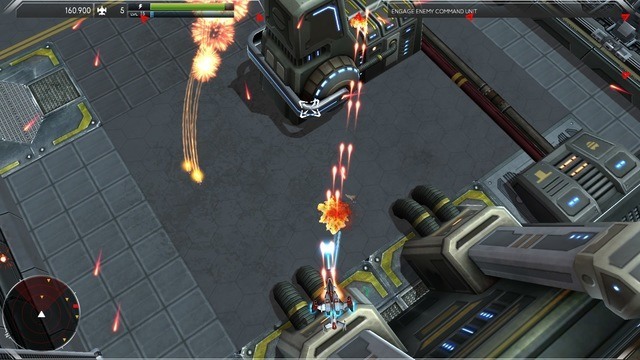Project Root’s world is a mixture of biological and mechanical. Its scenery is dotted with forests, which are interrupted by cavernous pits of machinery laid inground by Prometheus Corporation. The planet, it seems, is dying by their hand. There are no homes. No people. No activity other than pockets of resistance and bullets of many colors swirling across the air.
Prometheus Corp owns the Earth in 2068. How they gained their financial power is unclear. There is no one left to buy their materials anymore, let alone a stock market to support their girth. They exist to create weaponry for protection against their feisty rebel opponents, who named themselves Arcturus. These warring factions are the sole signs of intelligent life.
Maybe there is an explanation for Prometheus’ funding. It’s just buried in text conversations littered with grammatical errors. Capitalization gaffes, general typos, punctuation flubs; such mistakes reveal Project Root’s independent origins. However, these origins adds weight to the routine “us versus them” anti-corporate posturing featured in this twin-stick outing – more so than games coming from studios with budgets mirroring summer box office reciepts.
There is an implicitness to the action. Arcturus pilot Lance Rockport – a far cheekier name than suits the already flailing fiction – blows up his opposition with a satisfying burst. The explosions are Project Root’s highlight. Such shapely fireballs are never tiresome. Maybe Project Root is reaching some of the firery luster of summer cinema after all.
Roto Rooter
Project Root’s design criminality is a lack of enthusiasm anywhere other than its flames. By the time it finds a spark, Project Root is near its end, and only then because a leveling system has caught up to its needs. Gaining levels is needed to make Project Root palpable rather than to merely increase numbers in defense and strength. Gaining XP is less a part of the twisty power fantasy than it is a bandage on this initially stagnate genre example.
Rockport’s ship, a low altitude fighter with the red & white paint scheme (prominent amongst Project Root’s more straightforward 16-bit predecessors), is rather helpless though. Movement across the free roaming maps is ponderous, weapons are inefficient, and special armaments are limiting. The odds are almost cruel. By Project Root’s unconscionably difficult finale, the odds prove nigh incalculable, a bullet swarm worthy of an empire versus a single rebel fighter, without a small thermal exhaust port in sight.
Movement is ponderous, weapons are inefficient, special armaments are limiting.
If anything, the title is correct: The downloadable end product feels like the roots of a grander project, one meant to be played and experimented with before being sharpened into a wide release.
As it sits now, the confounding invisible walls, consistent off-screen enemy fire, outright bad sci-fi, and dire lack of checkpoints on 50+ minute missions are inexcusable oversights.
Caught in its roots
Project Root needs two C’s: context and claustrophobia. Context, for the sake of its world now and should it ever be built upon later. Then, claustrophobic fear to generate authentic tension sweat, a response integral to the shoot-em-up. Here, bullets pass by in a rather laborious strafing contest until Project Root decides otherwise for the, “Look at all of the colored death” bullet dance finish.
This is Argentinian developer OPQAM’s first go-round. Their signs of talent lie in the respect for the traditional shooter.
This is Argentinian developer OPQAM’s first go-round. Their talent lies in a show of respect for the traditional shooter, even if they ignore the precision tension created by an eight-way d-pad for the sake of modern conventions – those of too-spacious open world maps and freedom of pacing. Both take away from the pressure. Such a shooter feels less like a desperate fight than it does a piece of combatative sight seeing.
Certainly, such terminology – “open world” and “freedom” – sounds great in trailers. But Project Root is caught between the classical and contemporary, picking and pulling bits from EA’s Genesis classic Desert Strike (and its sequels) while mulling it over with sessions of Sega’s awesome (and undervalued) Renegade Ops. Sadly, the two sides butt heads and leave Project Root stranded in the fight for a playable identity.










Published: May 1, 2015 07:47 am